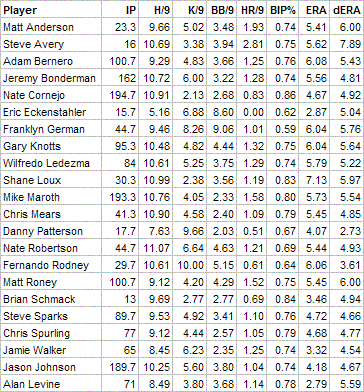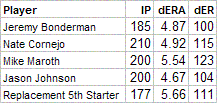Now that Pudge mania has died down, I figured it would be a good time to take a look at the pitching staff he’ll be handling. While the Tigers offense is bound to produce more runs, will it be enough to compensate for a pitching staff that gave up 928 runs last year? This was sufficient to keep them in next to last place in the AL despite playing in Comerica Park (Texas was last with 969 runs). While the starting rotation is 80% established, we’ll have to make some guesses on who will make up the bullpen. Actually, with a pitching staff so young, it is hard to make any sort of prediction on this years performance, but I’ll give it a stab anyways.
Starters
What a difference a year makes. Last year going into spring training the Tigers had no starters. This year they have 4/5ths of the rotation identified. Jeremy Bonderman, Mike Maroth, and Nate Cornejo are the holdovers from next year. They are joined by free agent acquisition Jason Johnson. Jason Johnson will be the number one guy in the rotation. His peripherals are only okay, but that still qualifies him as the ace of the staff. Also, his peripheral stats for the last several years have moved in a pretty narrow range, so it’s reasonable to expect a similar performance again this year.
Maroth did everyone but himself a favor by making 20 game loser Brian Kingman irrelevant last year. This doesn’t make Mike Maroth a bad pitcher, but calling him average might be generous. However, this was his first full season in the majors. His strikeout, walk, and hit rates were similar to his 2002 performance when he had 21 starts. However, he gave up 34 dingers, or 1.58 per 9 innings despite being a lefty in Comerica. If Maroth is going to continue to be a starter in this league he will have to improve his home run rate. This seems plausible because in 2002 he allowed only 7 HR’s in 128 IP (or .49/9 IP).
Jeremy Bonderman made his pro debut last year, and despite some struggles, and an ERA of 5.56 he definitely showed promise. He had a stretch in June where he went 4 games without walking a batter. He also had the best strikeout rate among other Tiger starters. Another plus for Bonderman is that his defense independent ERA was .75 runs lower than his actual ERA. Considering he wasn’t old enough to buy a beer last year, there is definitely hope for him. One disturbing split is that he had serious trouble against the Twins. In 5 games (4 starts) he only lasted 16 innings, and the Twins hit .477 against him. I know this is a small sample size, but given that the Tigers and Twins battle 19 times, I’m hoping this was just a fluke.
Nate Cornejo led the team in ERA and pitching win shares despite the fact that he allowed 13.5 baserunners per 9 innings. He had a microscopically low 2.13 strikeouts per nine innings, and allowed a tremendous amount of balls in play. Cornejo has the ability to throw a ton of innings, and if he pitches well enough to stay in games, it wouldn’t surprise me to see him top 200. His inability to strikeout opposing hitters may signal that his performance and ERA may suffer next year. However, with only one full season under his belt, it’s is hard to know what a “normal ” season will be for him.
The 5th starter spot will most likely be held by quite a few different people. Those that are likely to see time include Gary Knotts, Nate Robertson, Rob Henkel, Wil Ledezma, Kenny Baugh, and possibly Preston Larrison if he can bounce back from a disappointing season at AA last year.
So this still doesn’t answer the question of what to expect from the rotation next year. Last year Tiger starters accounted for 61% of the innings pitched, which works out to about 5 1/3 innings per game. It seems reasonable to expect that with the addition of Jason Johnson, improvement from Bonderman (and probably a slightly relaxed pitch count), and my hope that Maroth can improve marginally by cutting down on his home run rate, that the Tigers starters can average 6 innings a game. Six innings per game equates to 972 innings. The table below shows my projections for innings pitched for 2004, and the pitcher’s DIPS ERA from last year. I arrived at the earned runs projection by applying last year’s dERA to my projection for IP. For the 5th starter, I used the the “replacement level” dERA from last year. Last year the Tigers starters allowed 562 ER’s in 885 IP. I’m projecting that the starters this year would allow 553 ER’s but in 972 innings.
Now there are some limitations with this analysis. I don’t really allow for any improvement by the pitchers, but given the age of the pitching staff it is hard to measure how much they will improve. Also, if the bullpen improves, the starters should be charged with fewer earner runs as well. Furthermore, this assumes that the Tigers defense is league average, which it wasn’t last year. I haven’t done any analysis yet to see if they will in fact be a better defense next year, but my gut tells me they will probably be below average as long as Sanchez is playing center. Hopefully on Monday I hope to have a similar analysis for the bullpen, and in the coming weeks I’ll be taking a closer look at the offense and defense as well. The plan is to zero in on runs allowed and runs scored projections so that I can make a moderately scientific prediction on wins and losses for the coming year.
As a point of acknowledgement, I found all the DIPS stuff at Jay Jaffe’s Futility Infielder. The other pitching stats came from a variety of sources. The starter/reliever split is courtesy of ESPN.com. The rest of the stats I had in a convenient Excel format courtesy of the TwinsGeek.

